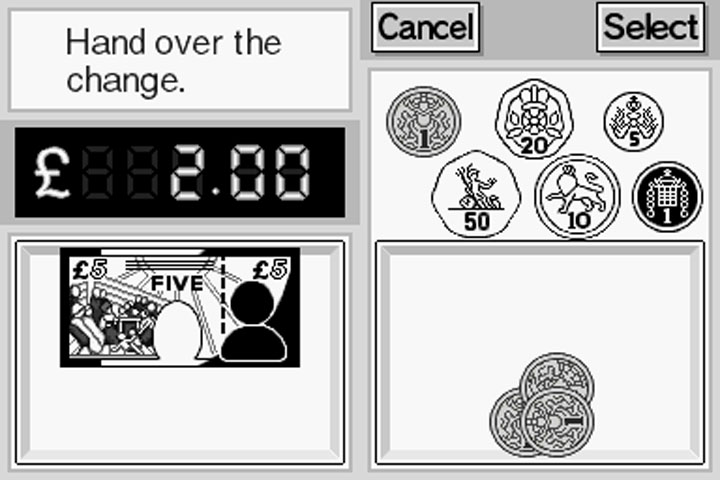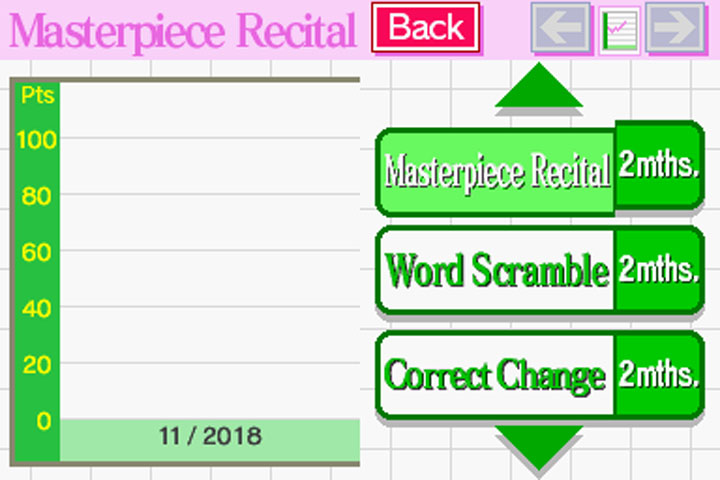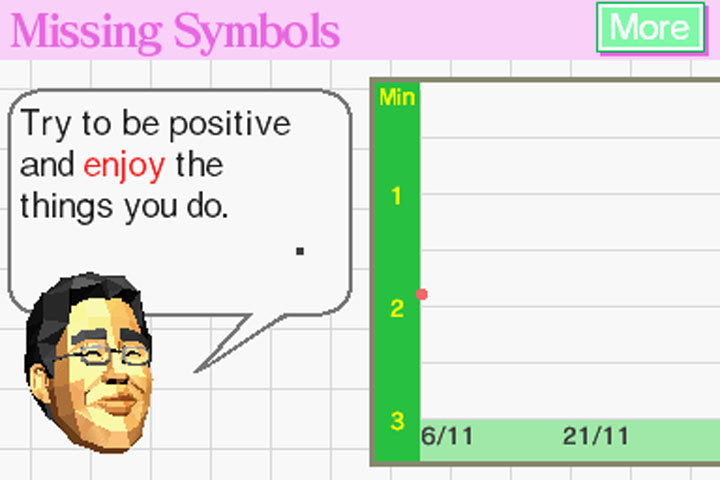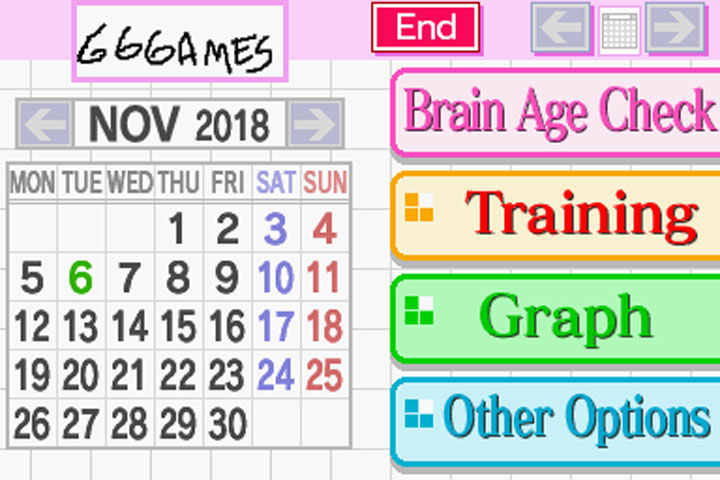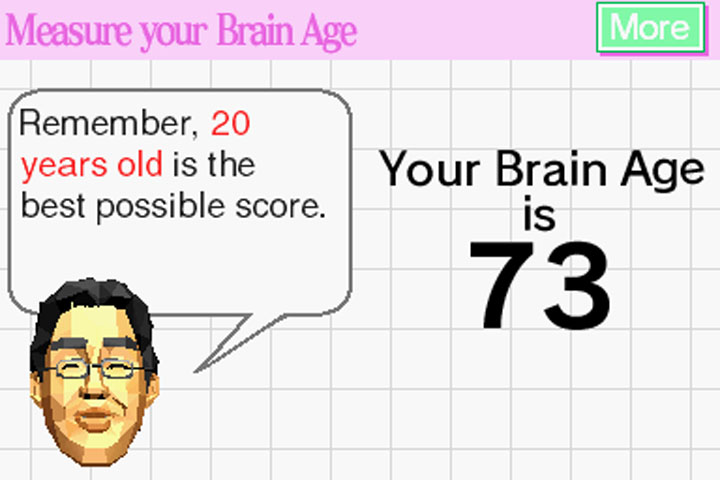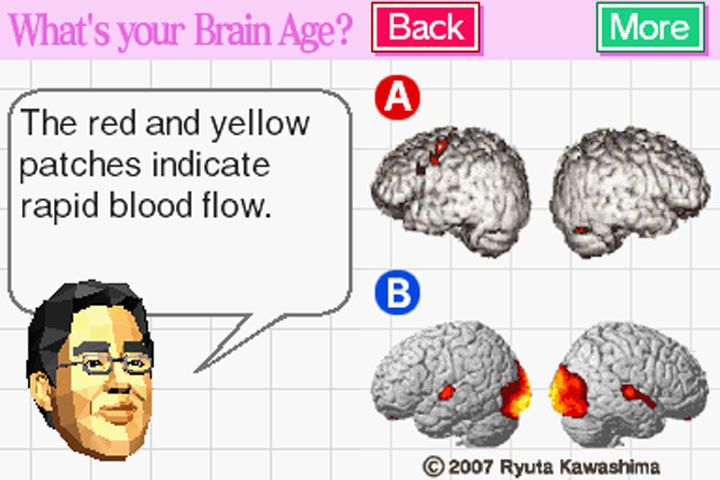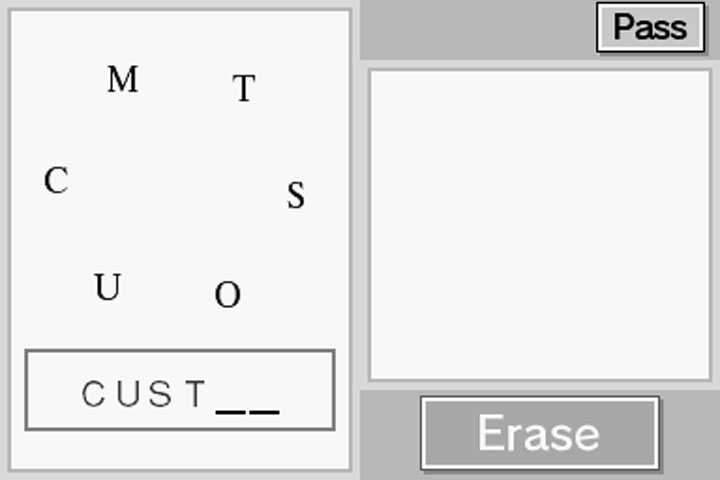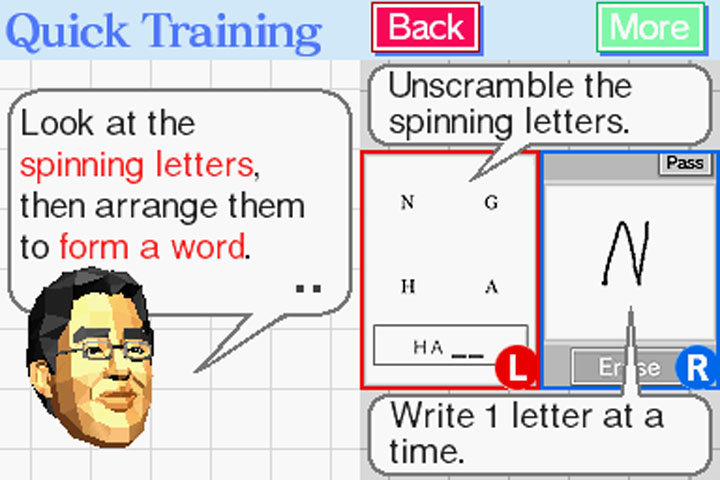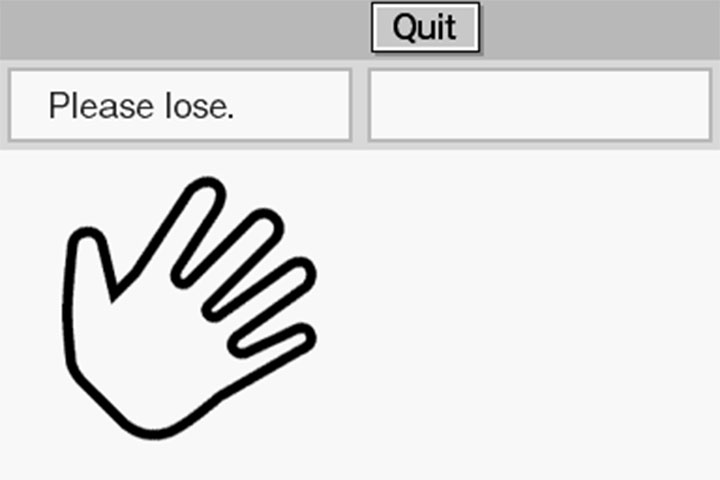More Brain Training from Dr Kawashima: How Old Is Your Brain? Review
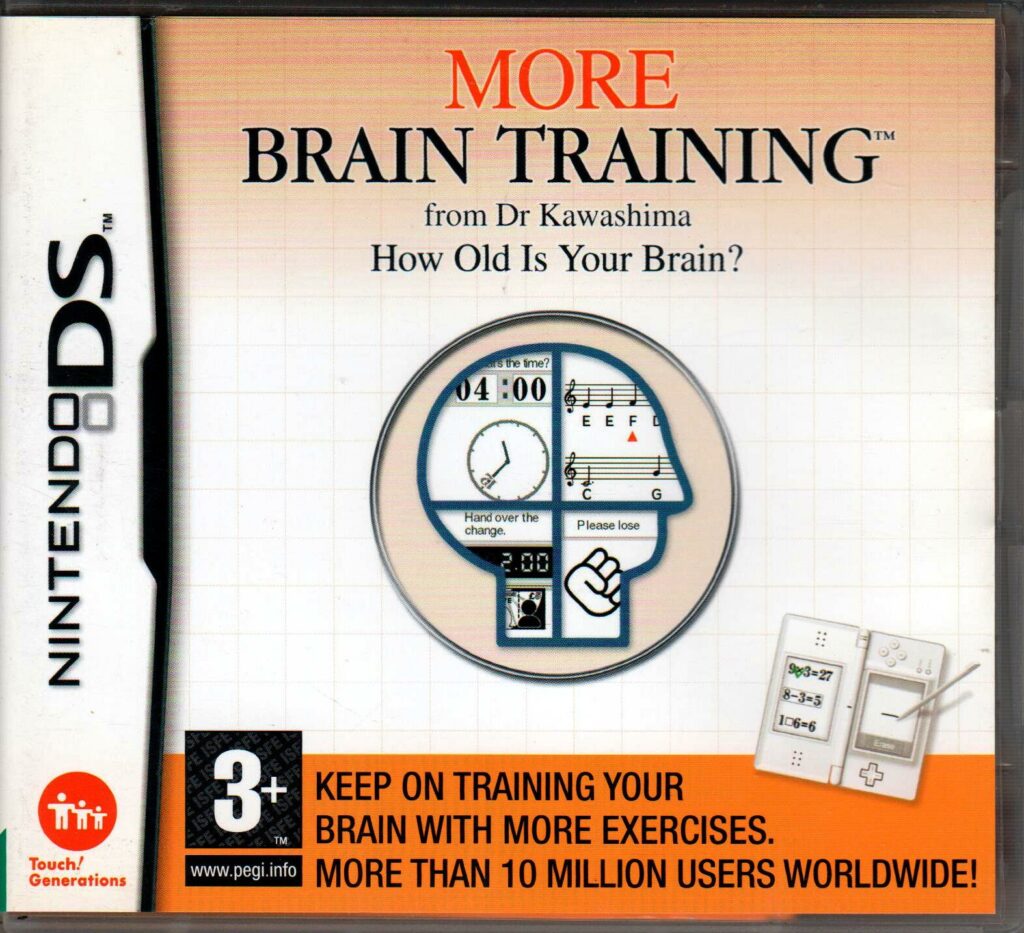
Stimulate your brain with Dr. Kawashima’s clever brain training program!
Introduction
Dr. Ryuta Kawashima has developed a program based on the theory that your brain can be trained and kept in good shape just like the other muscles in your body. To exercise your brain, you’d perform various tasks that challenge different parts of your brain. This is a way to stimulate it and proactively reinforce it. According to Dr. Kawashima this can prevent a decrease in brain function, especially as we grow older. He says that common symptoms are memory loss, or trouble articulating exactly what you want to say. Furthermore, he points out that both adults and children should use this training program to keep their brains in tip-top-shape.
The Game
More Brain Training from Dr Kawashima: How Old Is Your Brain? builds on the same design found in the previous game called Dr. Kawashima’s Brain Training: How Old Is Your Brain? of the same series.
The concept is very basic – Dr. Kawashima is a virtual doctor who will talk to you about various interesting facts about the brain and how it functions, and each day he will present a series of exercises for you to do. The program keeps track of your personal scores and you’ll be able to see your own improvement just after a few days of training.
Content
All in all, this game includes around 20 different exercises (including a few extra hard variants). The exercises are like mini games, each with their own high score table that will keep track of your personal best scores. Before each exercise Dr. Kawashima will explain what the exercise is about and give you all the instructions you need.
Some examples of the exercises are the Piano Player, in which you’ll see a song sheet and to avoid the song from being interrupted you’ll need to tap the missing notes on a piano with the stylus at the right time.
Another example is the Change Maker where you must calculate the correct amount of change – the faster you are, the better your score.
There is also a bunch of exercises that relate to mathematics and memory training, but it’s not as intimidating as it may sound. The math problems aren’t advanced at all. Rather, they are kept very basic (mental arithmetic) and instead it is the amount of time it takes for you to solve it what matters – you can take your time but your score will suffer. This dynamic I think is a great way to encourage the player to attempt to increase their performance over time.
The general idea here is that you should train your brain on a regular basis – the Daily Training program takes only a few minutes to complete, so doing this on a daily basis is by no means an impossibility even if you lead a very busy life. Once per day your score will be recorded on a graph and a calendar in the game. You can repeat the Daily Training, but it will not count towards your personal records.
The Training mode allows you to freely repeat any exercise and is perfect if you want to focus train some specific exercise, perhaps the ones you find the hardest.
Once you have done your Daily Training, you are ranked based on your performance. This gives you your current ‘Brain Age’ rating, which is then compared to your actual age. By doing the Daily Training for a few days, you’ll hopefully be able to fare better in the exercises as you become more familiar with the software. Thus you can lower your Brain Age from one day to another and eventually you’ll find your optimal rating.
Not all exercises are available to you from the start, however. Some of them must be unlocked by taking part in the Daily Training. Basically, the more you play and the better you do the more exercises will become unlocked. The game does not tell you what exactly you must do to earn a new unlock, so we suggest looking it up in a guide if you really want to unlock everything.
The most prominent unlockable is the Germ Buster game that closely resembles Dr. Mario and is highly addictive – it’s basically a puzzle game in which you defeat viruses of different colors by matching them with medicine pills of the same colors.
There’s also a very extensive Sudoku mode that has no less than 100 different Sudoku puzzles of varying difficulty – if you’re into this sort of thing, you’ll be right at home here.
Dr. Kawashima is always eager to provide you with advice and useful facts, and it really gives the game true value – it’s really more than just a game, in the traditional sense. By presenting you different kinds of mental exercises, it’s more than likely that you’ll discover strengths and weaknesses of your brain that you perhaps were unaware of.
Perhaps the biggest draw of More Brain Training from Dr Kawashima is that it is very approachable for casual players. It is translated to six different languages (English, German, French, Spanish, Italian and Dutch). The game is sure to inspire people who normally don’t play games and thanks to the various mini games, there’s something for everybody.
The most amazing thing about More Brain Training from Dr Kawashima is that the better you become, the bigger the challenge becomes. The game adapts to your skill and increases or decreases the difficulty level accordingly – so no matter how good or bad you are, the game will always challenge you at an appropriate level, which is a really neat feature.
Controls
This game is controlled with the stylus, and it mostly involves dragging and dropping items, writing letters or numbers and tapping objects. The game recognizes written numbers very well and letters almost as good. Some letters, depending on how you are used to write them can be problematic in which case you need to figure out a new way to write it so that the software will recognize it properly. This can hamper your performance severely – even though the game is well done, it isn’t perfect in this aspect.
Moreover, the game is played by holding the DS sideways, like a book. Some people might find this a bit awkward, but we had no problems with it.
Some exercises require you to speak out loud. You can choose to opt out of these exercises, and that may be a good idea, because the voice recognition tends to fail, making you feel like a fool. Background noise tends to cause the most problems – you need to be in a quiet environment if you want to do these exercises. You’ll also need to find the optimal distance between you and the DS Microphone as you can’t be too close to it.
Multiplayer
The multiplayer mode supports up to 16 players at a time with just one copy of the game. The following multiplayer modes are available;
• Vs. Picture Drawing
• Vs. Word Scramble
• Vs. Number Memory
• Vs. Change Maker
With the right kind of people the multiplayer mode is sure to evoke a good laugh and a memorable social experience. While these mini games probably won’t keep you entertained for very long, they represent a nice selection of what Dr Kawashima’s brain training is all about.
The game supports four profiles to be saved, so you are encouraged to share your game with family and friends. All active profiles are integrated in a smart way – for example, you can compare your records with the other profiles. Dr. Kawashima encourages you to talk to the other profile owners about the various exercises and your results, and he sometimes even compares your efforts in a most diplomatic way.
Graphics
The graphical design is very minimalistic and doesn’t use much color at all. This gives the game a cold and sterile feel – quite like being at a health center for real, and that is intentionally done. It maintains the same theme though all the exercises – no big surprises here. The sparse graphics also helps in giving the game a more sincere tone rather than a thematically playful game. Thanks to its neutral and clean design, it can appeal to all ages and genders.
Sound
The sound and music maintain a mellow tone too – there are no exciting sounds nor music and this actually helps you in focusing on the game and the problems you are to solve – many exercises are mostly silent, where the sound effects are just there to give you feedback.
Summary
More Brain Training from Dr Kawashima: How Old Is Your Brain? is a nice mix of mind-bending challenges and fun puzzles. It offers a great way to combine mental exercises and pleasure. Thanks to the fact that the game challenges you all the time by raising the bar higher and higher as you get better, there will always be a challenge waiting for you. The game is perfect for anyone who likes various puzzles because Dr. Kawashima has some really tricky stuff going on here, and he presents it all in a very approachable way.
